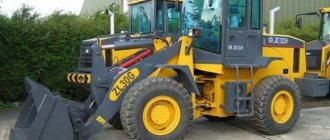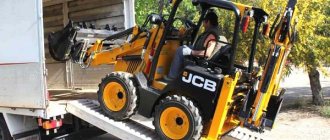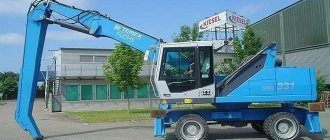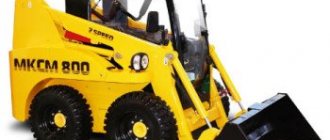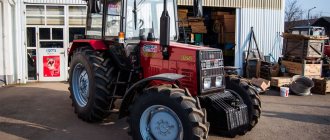The B 140 loader is a special construction equipment that is gaining great popularity due to the development of the construction industry. It is the embodiment of modern developments of both foreign and domestic companies, but has a lower cost compared to similar foreign equipment. The machine is designed for operation in various regions of Russia, while it copes with loading and unloading operations and transportation of materials. Applications include construction, mining, agriculture, etc.
Front loader B 140
Navigation
- Features and Benefits
- Technical characteristics and dimensions
- Modifications
- Engine
- Device
- Chassis
- Operator's cabin
- Attachments
- Cost of new and used
We produce special equipment that is positioned as a reliable manufacturer. The great demand for the products of this plant is due to the use of advanced technologies and innovative design solutions in the development of equipment. In 1998, the first B-138 machine appeared, which was very popular, and already in 2008 the B-140 loader rolled off the assembly line. It is not a modification of the B-138, but was developed as a separate independent unit.
The main area of application is construction, where the ChSDM V 140 loader works with category I and II soils with a density of up to 1.8 t/m3. For movement between work sites, the use of transport mode is provided.
Return to navigation
Features and Benefits
The front-end loader ChSDM V 140 is equipped with pneumatic wheels and a hydromechanical transmission. Thanks to its design features, it performs loading and unloading operations with clastic and bulk materials, soils no higher than category II, transportation of materials, earthworks (territory planning, loading earth into machines or dumps), construction (rigging, installation, etc.), road -repair work.
When developing the machine, the wishes of consumers were taken into account, processes were optimized, the work cycle was shortened, modern technical solutions were introduced to increase the competitiveness of the B 140 loader. In addition, the kinematics of the boom mechanism changed slightly compared to previous models, which made the equipment more productive and increased the speed of execution work operations. Model B-140 can be used in temperate and tropical climates.
The designers paid special attention to improving performance, comfort, ease of maintenance and compliance with international standards for functionality. As a result, the loader began to have such qualities as reliability, durability, wear resistance, safety and high quality parts. The greatest efficiency is achieved when using the machine in construction, warehouses, quarries and ports.
The operator's cabin is glazed on all sides, the B 140 front loader is controlled by a joystick, and the steering wheel can be adjusted to the individual characteristics of the driver. An improved cab and improved hood design have completely changed the design of the loader. The material used for the hood is plastic or steel. At the back of the hood there is a cover that guarantees easy access to the engine compartment. The advantage of installing a muffler is a reduction in noise during operation of the power unit.
The only drawback of the model is its impressive weight, which became smaller after the car was modified.
Return to navigation
Design
The B-140 front loader is a classic representative of the modern approach to the design of such machines. It is built on an articulated frame, which, coupled with a revised and optimized layout of the main components, which makes it possible to lower the center of gravity, and the installation of wide-profile tires, provides the vehicle with good maneuverability and cross-country ability.
As standard, the loader is equipped with a domestic Yaroslavl-made diesel engine and a hydromechanical gearbox. If desired, this motor can be replaced with a German one from Deutz, which is characterized by reduced vibrations and noise. The hydromechanical transmission and axles can also be made in Germany.
The hydraulic system is connected through a coupling to the transmission on which the hydraulic pump is located. The role of a torque converter is performed by a converter, thanks to which it is possible to automatically adjust the speed of movement of the loader depending on the force generated on the bucket when working with the ground.
To reduce the work cycle time and, accordingly, increase work efficiency, a Z-shaped kinematic control scheme for attachments was used. The rotation of the bucket is controlled by one hydraulic cylinder.
In addition to the main bucket, it is possible to use various attachments: a double-jaw grab, a grab bucket, a snow blade, forks, etc. The ability to quickly change working equipment is provided by Italian Hydrocontrol hydraulic valves.
When developing this loader model, much attention was paid to the operator's cabin. It received all-round glazing, a sprung adjustable seat, and an Italian adjustable steering column. The cabin is noise and heat insulated, a heater is installed, air conditioning is optional, and meets the international safety standards ROPS (rollover protection) and FOPS (large objects falling onto the cabin). The working equipment is controlled using joystick handles.
In 2010 the loader was modified. The B-140.1 modification became 1500 kg lighter due to a different frame design, changes in the tail, hood design, cabin modernization, etc. The new standard bucket has a smaller volume than its predecessor, and the lifting capacity has also been reduced to 4000 kg.
Instead of Raba bridges, Chinese Feicheng Jincheng bridges can be used.
Other changes include:
- Increased ground clearance.
- The design of the rocker arm has been revised, which has a beneficial effect on the kinematics of the working equipment.
- Easier access to the engine and other components and assemblies.
Technical characteristics and dimensions
High productivity is due to the excellent technical characteristics of the B 140 loader:
| Parameter name | Meaning |
| Breakout force | 12.1 t |
| Load capacity | 4.5 t |
| Turning radius | 5.9 m |
| Maximum unloading height | 3.09 m |
| Volume of standard working body | 2.5 m3 |
| Standard bucket width | 2.5 m |
The special equipment is maneuverable and capable of performing work in confined spaces. To work with machines with high sides, it is possible to unload the bucket at a height of more than 3 m. Due to the small width of the bucket, it is possible to move independently on public roads.
Return to navigation
Front loader B-140
It has been producing construction equipment, including front-end loaders, for several decades. The well-proven products of this domestic brand are one of the most popular on the market.
The very popular B-138 front loader model, produced since 1998, was replaced in 2008 by the B-140. This is a completely new model and is not the result of a modernization of the previous loader.
The design being developed was based on maximum functionality of the machine, corresponding to similar models from foreign companies, ease of maintenance, workplace comfort, performance and reliability.
Photo of front loader B 140
This loader is designed for use with soils with a density of 1.4-1.8 t/m3 (categories 1 and 2). He can move between work sites independently along regular roads.
The disadvantages include the weight of the loader, but after modification the B-140 began to weigh less.
Modifications
The first modification B-140.1 appeared in 2010. It features a weight reduction of 1.5 tons due to the installation of a lightweight frame, improved wings, a modified hood and a modernized cabin. At the same time, the loader can handle loads weighing up to 4 tons using a standard bucket of reduced volume.
Various axles can be installed on the vehicle (Raba or Feicheng Jincheng). Also distinctive features include increased ground clearance, an improved boom mechanism, and simplified access to the engine compartment.
| Modification | B-140 | V-140.1 |
| Engine | YaMZ-236M2 / Deutz TCD1013 | |
| Power, hp (kW) | 180 (132)/173 (129) | |
| Specific fuel consumption at rated power, g/kWh (g/hp-h) | 227 (167) | |
| Torque, Nm | 667/670 | |
| Transmission | Hydromechanical, ZF 4WG-180 | |
| Maximum speed, km/h | 36 | |
| Load capacity, kg | 4500 | 4000 |
| Bucket capacity, mm | 2500 | 2450 |
| Max. unloading height, mm | 3050 | 3100 |
| Max. bucket unloading angle, degrees | 45 | |
| Max. digging depth, mm | 50 | |
| Breakout force, kN | 121 | |
| Frame | articulated | |
| Frame folding angle, degrees | ±35 | |
| Weight, kg | 1450 | 13000 |
| Dimensions, LxWxH | 7705x2500x3750 | 7700x2500x3800 |
Return to navigation
Maintenance
You should continually monitor the condition of the most expensive parts of your forklift to maintain, as well as maintain an ongoing interest in and use of advanced inspection methods, techniques and materials that can help extend the life of these components and reduce equipment operating costs.
The areas that wear the most on loaders are the boom pins, buckets, bucket wear plates and teeth. Wear increases if maintenance is not performed regularly. Perform lubrication promptly and in accordance with the instructions in the Operating Manual. Promptly turn over the unworn side or replace the bucket skid plates before the metal of the bucket begins to wear out.
When inspecting the machine daily, check fluid levels. Before starting work, it is necessary to drain the condensate from the tank to avoid water entering the fuel system. Carefully monitor the quality of the fuel used to fuel your vehicles. Fill the fuel tank at the end of each working day. This will reduce the formation of condensation in the tank and avoid wasting time on refueling during the working day.
Check your tire pressure regularly. Incorrect tire pressure is a common cause of excessive tire wear. Tires often get damaged due to incorrect pressure. Low pressure causes tires to heat up intensely because the tire deforms excessively under load and internal friction occurs. Overheating causes the rubber compound to lose its elasticity and the service life of the tire is reduced. If tire pressure is uneven, the loader will tilt to one side when operating and the bucket cutting edge will wear unevenly. When the tire pressure is correct, the load capacity of the forklift is maximum.
The author expresses gratitude for the assistance in preparing the article to specialists, John Deere company, Liebherr-Rusland LLC.
Maud. W136 with a payload of 3200 kg is equipped with Yuchai, Cummins or Deutz engines, planetary transmission, and disc brakes on all wheels. The working equipment is controlled by a joystick. In addition to the basic bucket, optional rock buckets, 4-in-1 multi-function buckets, log grabs, pallet forks, quick-release attachment couplers, and reach booms are available as options.
Maud. W136II with a capacity of 4000 kg is equipped with Yuchai, Cummins or Deutz engines, a transmission with a torque converter from a 5-ton loader, and an increased power hydraulic system.
Maud. W153 and W156 with a payload of 5000 kg are equipped with Weichai, Caterpillar or Cummins turbocharged engines, a planetary transmission with two forward and one reverse gears, disc brakes on all wheels, and the cabin is equipped with air conditioning. The working equipment is controlled by a joystick. In addition to the basic bucket, optional rock buckets, 4-in-1 multi-function buckets, log grabs, pallet forks, quick-release attachment couplers, and reach booms are available as options.
Important Characteristics and attachments for Oka walk-behind tractors MB-1D1M10 and MB-1D2M16
All models of loaders are equipped with power steering and a comfortable cabin with air conditioning.
| Parameter | W136 | W136II | W153 | W156 |
| Operating weight, kg | 10 000 | 11 000 | 16 600 | 16 200 |
| Load capacity, kg | 3200 | 4000 | 5000 | 5000 |
| Bucket capacity, m3 | 1,8 | 2,2 | 3,0 | 3,0 |
| Unloading height, mm | 3060 | 3060 | 3050 | 2970 |
| Engine | Yuchai, Cummins, Deutz | Yuchai, Cummins, Deutz | Weichai | Weichai, Caterpillar, Cummins |
This is interesting: Design and technical characteristics of the L-34 front loader
Engine
The characteristics of the ChSDM V-140 depend on the power unit mounted on the loader. A domestic system produced by YaMZ with a capacity of 132 kW or 180 horsepower is installed as standard. Model 236M2 operates in conjunction with a hydromechanical gearbox.
Optionally, the manufacturer offers to install a Deutz engine that meets the Tier 3 exhaust quality class. The German model TCD1013 is characterized by low noise and vibration levels during operation. Transmission and axles can also be installed from Germany.
Both engines are four-stroke six-cylinder, equipped with an electric starter. They have a large reserve of power, which, together with a four-speed gearbox, makes it possible to travel at speeds of up to 37 km/h.
If necessary, all elements of the fuel system can be replaced in any region of Russia. The manufacturer foresaw the possible needs of equipment owners and organized regional spare parts warehouses.
The fuel consumption of the ChSDM V 140 loader is about 227 g/kW per hour of operation, or 167 g/hp. over the same period of time.
Return to navigation
Device
The front loader is built on the basis of an articulated main part. This makes it possible to reduce the turning radius and use the loader in cramped conditions. The main functional units are designed taking into account ease of maintenance and ease of use. These changes had a positive effect on the location of the center of gravity; it became somewhat lower. Maneuverability and increased maneuverability are also due to the installation of wide-profile tires.
A design feature is the installation of an elastic coupling with a drive on a hydromechanical gearbox. This unit is installed in place of the pump drive gearbox on the motor and the intermediate support of the cardan transmission, and is located in the front of the machine. The B 140 loader transmission houses a twin hydraulic pump that pumps hydraulic fluid to the main equipment and steering wheel. The gearbox is connected to the front axle via a cardan shaft with a hinge.
The gearbox hydraulic converter acts as a hydraulic transformer; it changes the speed in autonomous mode, taking into account the rolling resistance of the pneumatic wheels or the working element. The advantages of this technical solution include streamlining the operation of the power plant, increasing the dynamics and maneuverability of the equipment.
Return to navigation
Type of lifting mast
The lifting mast is another significant working part of a forklift, so its characteristics include:
- number of sections,
- minimum and maximum height,
- fork angle,
- fork adjustment drive
- carriage lift height,
should also be taken into account when choosing.
The nature of the forks’ operation depends on the type of mast. So, there are two-section and three-section mast designs in which the forks can have free movement
It is also worth paying attention to such a parameter as the speed of lifting the mast, which affects the efficiency and accuracy of work operations.
Chassis
Correct weight distribution of the loader ensures increased work efficiency and improved technical characteristics of the machine. For this purpose, the wheelbase was increased and a one-piece counterweight was mounted, which ensured the required balance. Thanks to the installation of wide tires, reliability and stability are guaranteed in all situations.
Return to navigation
Operator's cabin
The modern operator's cabin is characterized by safety, reliability, modern design and great functionality. The operator can fully control the work process and the position of the machine on the work site thanks to panoramic glazing. Driver comfort is ensured by installing an adjustable seat with springs and an adjustable steering wheel (made in Italy). The salon is completely isolated from noise, vibration and dust; a heating system is installed here, which maintains a comfortable temperature when working in winter. Installation of an air conditioning system is an option. Protection is provided by FOPS and ROPS systems, which are also part of the standard build. Joysticks are provided to control mounted parts.
The ChSDM V 140 loader is equipped with a convenient and ergonomic dashboard. If necessary, you can install a radio and audio system in standard compartments. The pedals are also made in Italy; they are used to control the motor and handbrake by cable.
Return to navigation
Attachments
The movement pattern of the boom mechanism has changed compared to the popular B-138 model. Zigzag kinematics operate under the action of one hydraulic cylinder, which is responsible for tipping the working element. This provides a breakout force of 115 kN, and the tilting angle of the working body of the standard assembly in the lower part is 50 degrees. Such technical solutions have led to a shorter work cycle, which is also an advantage. To work with additional bodies, Italian Hydrocontrol hydraulic distributors, controlled via joysticks, are provided.
In addition to the standard 2.5 m3 bucket, the following quick-release equipment can be installed:
- snow blower;
- bulldozer blade;
- pitchfork;
- rock bucket with replaceable knives and dismantled teeth, etc.
With their help, the scope of application of special equipment is expanding. A double-jaw bucket is a universal working tool that can be used to perform loading and unloading operations with bulk and debris materials, pallet loads, scrap metal, etc. The jaw grip is designed for working in difficult conditions, the forks are designed for loading large and heavy loads into bulk, stacks or onto a rack.
Return to navigation



